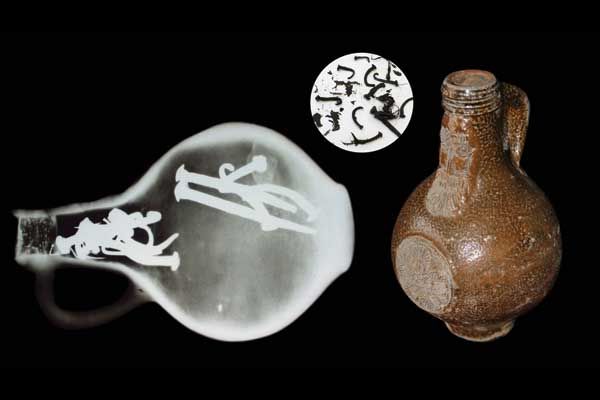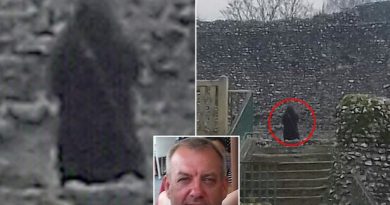Unexplained Mysteries of Witch Bottle
The witch bottle is a very old spell device. Its purpose is to draw in and trap harmful intentions directed at its owner. Folk magic contends that the witch bottle protects against evil spirits and magical attack, and counteracts spells cast by witches.
A traditional witch bottle is a small flask, about 3 inches high, created from blue or green glass. Larger and rounder witch bottles, up to 9 inches high, were known as Greybeards and employed so-called Bartmann or Bellarmine jugs. Bellarmines were named after a particularly fearsome Catholic Inquisitor, Robert Bellarmine, who persecuted Protestants and was instrumental in the burning of Giordano Bruno . Greybeards and Bellarmines were not made of glass, but of brown or gray stoneware that was glazed with salt and embossed with severe bearded faces designed to scare off evil.
A witch, cunning man or woman, would prepare the witch’s bottle. Historically, the witch’s bottle contained the victim’s (the person who believed they had a spell put on them, for example) urine, hair or nail clippings, or red thread from sprite traps. In recent years, the witch’s bottle has taken on a nicer tone, filled with rosemary, needles and pins, and red wine. Historically and currently, the bottle is then buried at the farthest corner of the property, beneath the house hearth, or placed in an inconspicuous spot in the house. It is believed that after being buried, the bottle captures evil which is impaled on the pins and needles, drowned by the wine, and sent away by the rosemary.
Sometimes seawater or earth are used instead. Other types of Witch-bottles may contain sand, stones, knotted threads, feathers, shells, herbs, flowers, salt, vinegar, oil, coins, or ashes. A similar magical deceive is the “lemon and pins” charm.
Another variation is within the disposal of the bottle. Some witch’s bottles were thrown into a fire and when they exploded, the spell was broken or the witch supposedly killed.
This form of “bottled spell” dates back hundreds of years, and were prevalent in Elizabethan England – especially Anglia, where superstitions and belief in witches were strong. The bottles were most often found buried under the fireplace, under the floor, and plastered inside walls.
The Witch-bottle was believed to be active as long as the bottle remained hidden and unbroken. People did go through a lot of trouble in hiding their Witch-bottles – those buried underneath fireplaces have been found only after the rest of the building has been torn down or otherwise disappeared. The origins of this tradition have been dated at least to the 16th century. In ancient times the bottles were made of stone and originally contained rusty nails, urine, thorns, hair, menstrual blood, and pieces of glass, wood, and bone.
The practice of concealing witch-bottles appears to have started in the sixteenth century. Almost invariably in the 16th and 17th centuries a grey stoneware bottle colloquially known as the bellarmine was used. It got its name (after the practice began) from a Cardinal called Bellarmine who published much anti-Protestant literature. These bottles are pot bellied and have masks stuck onto them of a grim looking bearded man. The bottles are mostly of German stoneware and are known as bartmann bottles.
During and after the 16th and 17th centuries glass bottles were also used for the practice, although, based on the current information in the archive, the practice appears to have been generally less popular after this period. See the photo above of the two Pershore glass phials – they were part of a 19th century hoard of concealed items.
Witch-bottles are usually found concealed beneath the hearth or threshold but sometimes beneath the floor and in walls. Of around 200 English witch-bottles on record, 130 are bellarmines. The contents of these bottles are fascinating and appear to constitute a kind of spell. Of the contents which are identifiable, by far the most common was iron pins or nails (95%). The second most common was human hair (25%). Another ingredient which is very difficult to test for if the bottle has leaked at any point is urine. Roughly 25% of those with contents have been tested for the presence of urine and all proved positive. So, we have iron, urine and hair as the most common ingredients. Other ingredients such as small bones, thorns, pieces of wood and, in a few cases, pieces of fabric cut into the shape of a heart are sometimes found.
The locations in which these bottles are found is significant. There is an emphasis on placing these objects at entry and exit points of the building. The hearth was and is always open to the sky and represented a major security worry where supernatural entities were concerned. The doorway was naturally the other place that would need protecting as it would be opened and closed at regular intervals day or night. The use of iron pins in the bottles is significant as it had always been regarded as a magical metal.
The effort which went into concealing these bottles was large. How fearful of supernatural intrusion into your home would you have to be before you’d consider lifting your hearthstone, digging a hole and inserting a bottle filled with pins and urine?
During the 17th century in England, someone urinated in a jar, added nail clippings, hair and pins, and buried it upside-down in Greenwich, where it was recently unearthed and identified by scientists as being the world’s most complete known “witch bottle.”
This spell device, often meant to attract and trap negative energy, was particularly common from the 16th to the 17th centuries, so the discovery provides a unique insight into witchcraft beliefs of that period, according to a report published in the latest British Archaeology.
Lead researcher Alan Massey, a former chemist and honorary fellow of Loughborough University, believes “the objects found in witch bottles verify the authenticity of contemporary recipes given for anti-witchcraft devices, which might otherwise have been dismissed by us as being too ridiculous and outrageous to believe.”
An Old Bailey court record from 1682 documents that a husband, believing his wife to be afflicted by witchcraft, was advised by a Spitalfields apothecary to “take a quart of your Wive’s urine, the paring of her Nails, some of her Hair, and such like, and boyl them well in a Pipkin.”
The excavated bottle appears to have been made according to those, or similar, instructions.
CT scans and chemical analysis, along with gas chromatography conducted by Richard Cole of the Leicester Royal Infirmary, reveal the contents of the bottle to include human urine, brimstone, 12 iron nails, eight brass pins, hair, possible navel fluff, a piece of heart-shaped leather pierced by a bent nail, and 10 fingernail clippings.
Real Indiana Jones mysteries Although some 200 early witch bottles have been identified, all were found opened, with their contents likely eroded or otherwise lost. This artifact, in contrast, had its cork closure still intact.
The urine contained nicotine, so a smoker produced it. Since the fingernails showed little wear, Massey believes the individual was “of some social standing.”
Brimstone, the ancient name for sulfur, is associated with passages in several religious texts, including the Bible. In the Book of Revelations, for example, “false prophets” were cast into a volcano-like lake “burning with brimstone.”
In terms of the heart object, Massey said other witch bottles were found to contain “a cloth heart pierced by brass pins,” but “this is the first example where a nail was used for this function.” The meaning remains unclear.
The bottle itself is actually a salt-glazed jar made in the Netherlands or Germany and stamped with the face of Cardinal Roberto Bellarmino (1542-1621), who played an important role in the Catholic Reformation.
Massey believes witch bottles “emphasize just how frightened people were of the ‘black arts’ the early settlers even took their superstitions to the New World with them as excavated witch bottles demonstrate.”
The general time period of the bottle coincides with the Salem Witch Trials, which happened in late 1600’s America.
Archaeologist Mike Pitts, the editor of British Archaeology, told Discovery News, “The discovery of something so apparently bizarre, indicating a clear belief in witchcraft and forces that have nothing at all to do with conventional, approved religion, remind us that early modern England did not belong to the same world we now inhabit.”



